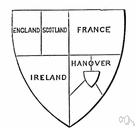George I 1
1660-1727. Elector of Hanover (1698-1727) and king of Great Britain and Ireland (1714-1727) who left the affairs of his country in the hands of Sir Robert Walpole.
George I 2
1845-1913. King of Greece (1863-1913) who was elected by the Greek Assembly and introduced a democratic constitution (1864).
American Heritage® Dictionary of the English Language, Fifth Edition. Copyright © 2016 by Houghton Mifflin Harcourt Publishing Company. Published by Houghton Mifflin Harcourt Publishing Company. All rights reserved.
George I
n
(Biography) 1660–1727, first Hanoverian king of Great Britain and Ireland (1714–27) and elector of Hanover (1698–1727). His dependence in domestic affairs on his ministers led to the emergence of Walpole as the first prime minister
Collins English Dictionary – Complete and Unabridged, 12th Edition 2014 © HarperCollins Publishers 1991, 1994, 1998, 2000, 2003, 2006, 2007, 2009, 2011, 2014
ThesaurusAntonymsRelated WordsSynonymsLegend:
| Noun | 1. |  George I - Elector of Hanover and the first Hanoverian King of Great Britain and Ireland from 1714 to 1727 (1660-1727) George I - Elector of Hanover and the first Hanoverian King of Great Britain and Ireland from 1714 to 1727 (1660-1727)Hanoverian line, House of Hanover, Hanover - the English royal house that reigned from 1714 to 1901 (from George I to Victoria) |
Based on WordNet 3.0, Farlex clipart collection. © 2003-2012 Princeton University, Farlex Inc.